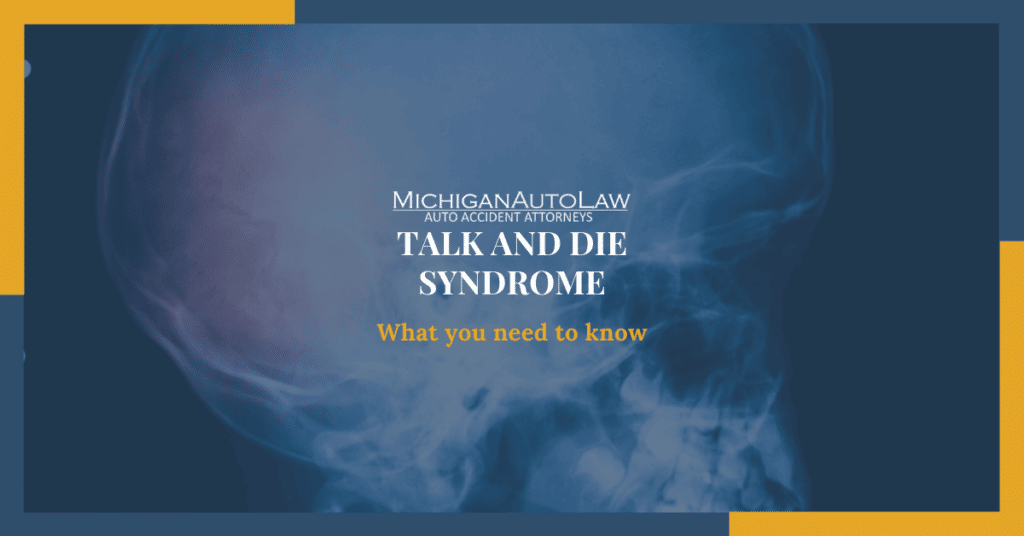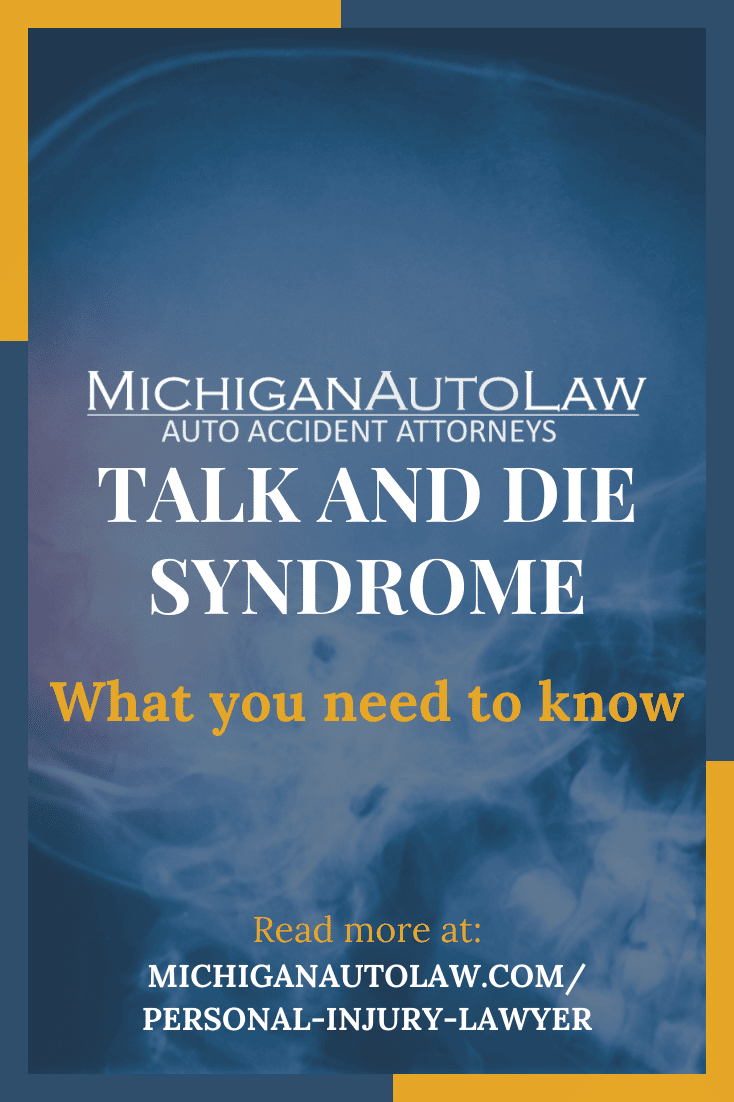What Is Talk and Die Syndrome: When Head Injuries Become Deadly

Talk and Die Syndrome occurs when a victim suffers head trauma but fails to seek medical attention because he or she initially feels fine and is acting seemingly normal. Tragically, the untreated head trauma eventually results in neurological damage and death.
Many might consider Talk and Die Syndrome to be more of an “urban legend.” But it is very real, although thankfully not common. Nevertheless this fatal syndrome highlights just how serious even the most seemingly minor head injuries can be. The serious and potentially life-threatening effects of any TBI, concussion, or closed head injury are often not immediately obvious to auto accident victims and to their loved ones, but all brain injuries need to be taken seriously.
You can have a serious brain injury without losing consciousness. A brain injury may even grow more deadly as it goes undiagnosed and untreated as chemical and inflammatory changes occur in the brain following trauma. There is a reason why brain injury specialists now refer to TBI as a process, not an event. CDC brain injury guidelines and TBI medical experts advise people to be wary as many symptoms of what may be a very serious TBI may appear in days or even weeks after a car accident.
The main lesson is to stay vigilant and promptly seek medical attention if and when TBI or any type of closed-head injury symptoms appear. Just because a car accident victim appears fine immediately after a crash does not mean the victim has been lucky enough to avoid a potentially deadly closed head injury.
What is Talk and Die Syndrome?
Talk and Die Syndrome is a term used to describe a situation where a person suffers a head injury and seems to be fine, talking and interacting normally. However, underlying internal injuries or bleeding within the brain progresses rapidly causing the person to die from an undiagnosed traumatic brain injury (TBI).
The threat posed by this is significant given that the signs and symptoms of a brain injury are not always immediately apparent. They may not show up until days or even weeks after a car accident or traumatic event. Or as is the case in with this syndrome they might never show up before the TBI has done its fatal damage.
Talk and Die Syndrome how long
There is no set amount of time for how long it will take for Talk and Die Syndrome to occur. It’s not uncommon for someone with an underlying TBI or brain bleed to appear and act “normal” for as little as 5 minutes or as much as an hour before losing consciousness and ultimately succumbing to their injury.
Talk and Die Syndrome symptoms
The Talk and Die Syndrome symptoms to watch for after a person suffers a blow to the head or any other kind of head injury include: (1) sudden loss of consciousness; (2) confusion; (3) dizziness; (4) difficulty with memory or concentration; (5) slurred speech; (6) headaches; and (7) drowsiness.
Talk and Die Syndrome & Actress Natasha Richardson
Sadly, the most infamous example of the Talk and Die Syndrome involved the tragic death of actress Natasha Richardson in 2009.
Ms. Richardson had been skiing on a “bunny hill” with her child when she fell and hit her head. Afterwards she was talking and laughing. She did not seek medical attention. Later in the day, she went to the hospital after she began experiencing a headache. At the hospital, she fell into a coma and ultimately passed away. An autopsy revealed she had suffered an epidural hematoma.
An epidural hematoma, which can be caused by blunt force trauma (from either falling on a ski slope or in a car accident), involves bleeding within the skull. Although the brain’s functioning may not be affected immediately, as blood accumulates between the brain and the skull, neurological damage will ultimately result from the pressure.
Significantly, the impact force to Ms. Richardson’s brain would have been less than what many people would experience in even a minimal low-impact auto accident with little or no vehicle damage. It’s an important lesson of why brain injury specialists and neurosurgeons do not ask to first see pictures of a car. A bumper does not reflect a brain.
The story of Natasha Richardson and her loss to Talk and Die Syndrome illustrates something that lawyers and medical professionals who help people with traumatic brain injury from auto accidents see all of the time: People can appear deceptively normal following a car accident — but still suffer a severe brain injury.
The lesson for all of us is to stay vigilant and promptly seek medical attention if and when head injury symptoms appear. Just because someone seems fine and looks “normal” does not mean a serious injury has not occurred.
Protecting yourself and loved ones
If you or a loved one suffered a closed head injury after a car accident, the best way to protect yourselves from Talk and Die Syndrome is to be vigilant, be observant and to be aware of symptoms. If you experience symptoms of a possible brain injury, seek medical attention immediately. Do not delay.
This is the same advice that an Emergency Room will give to you. It is now routine on emergency room discharge instructions to receive instructions that if you begin to experience symptoms such as headaches, nausea, dizziness or difficulties with memory and concentration in the hours, days or even weeks following a trauma to the head that it is vital to see a doctor or return to the emergency room IMMEDIATELY.
Need help finding the right lawyer for a traumatic brain injury after a car accident? Call Michigan Auto Law first
If you a loved one has suffered a traumatic brain injury (TBI ) after a car accident or has questions about Talk and Die Syndrome and you would like to speak to an experienced brain injury attorney, call toll free anytime 24/7 at (800) 968-1001 for a free consultation with one of our attorneys. You can also get help from an attorney by visiting our contact page or you can use the chat feature on our website.






